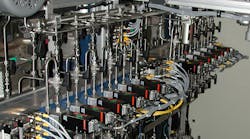Q: We have a batch fryer in our Food Processing plant. There is a gas flowmeter to record the flow of gas. We use LPG that is stored in a sphere, underground. The gas supplier bills us for LPG in MT (assume in liquid form). How do I calculate consumption and cost of the LPG per pound of cashews/nuts roasted. The flowmeter readings in cubic M/hr are recorded at the start of fryer and after shut down of fryer, during which time “X” lbs nuts would have been roasted. Obviously, we have to trace the consumption in vapor form to liquid form, to find out the costs.
A: First you need to know if the flowrate of gas mixture that is measured on real conditions with some pressure that is above atmospheric. Or is it already converted to standard conditions with volume corrector? If the flowrate that is measured is already converted to standard condition, calculation of mass flowrate is straight-forward. You must know the composition of mixture — propane butane ratio — like 30-70% or so. Then the density of that mixture can be calculated based on the density of every single component and its participation in mixture.
For the theory on how to calculate fluid mixture density, see:
www.pipeflowcalculations.com/pipeflowtheory/density-of-fluid-mixture.php
Component density should be used on standard conditions, and you can view the table for it at:
www.pipeflowcalculations.com/tables/gas.php
When you have the fluid-mixture density, then the measured flowrate should be multiplied with the density to determine weight flowrate:
G=Q x rho
where:
G = weight flowrate — which is the same for gas and liquid
Q = measured flowrate – volume
rho = mixture density
If the measured gas flowrate is not converted to standard conditions, then the density of every single component should be used on the pressure and temperature that is on the point of flowrate measurement. This means you should use component density on standard conditions using the gas state equation. Calculate density on a given pressure.
p1/rho1=RT1
p1/p2 * rho2/rho1 = T1/T2
if 1 – is for standard conditions then
rho2 = rho1 * T1/T2 * p2/p1
The preceding Q&A is based on an exchange on PipeFlowCalculations.com, a website featuring calculators and a forum that focuses on fluid flow.

